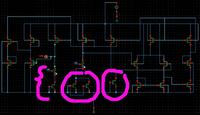aredhel_vlsi
Member level 4

Hello, I have a problem with a bandgap reference voltage. I have some questions;
1)At a 0.18um technology what voltage reference value should I expect? I tried 1.07 Volt and I think it is ok.
2)My dc temperature analysis is very good, with 0.45 % error at 0-85 celsius values but
what could I do to optimize my V dc analysis ? I manage 15% error which is terrible, I know! any suggestion would be appreciated!
ps; I tried to add some (until 4) diode connected BJT in parallel but I cannot achieve better results. is the number small? do I need a lot more?
1)At a 0.18um technology what voltage reference value should I expect? I tried 1.07 Volt and I think it is ok.
2)My dc temperature analysis is very good, with 0.45 % error at 0-85 celsius values but
what could I do to optimize my V dc analysis ? I manage 15% error which is terrible, I know! any suggestion would be appreciated!
ps; I tried to add some (until 4) diode connected BJT in parallel but I cannot achieve better results. is the number small? do I need a lot more?





